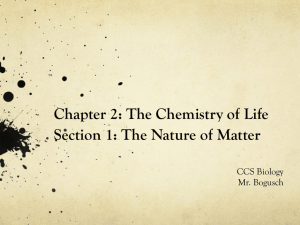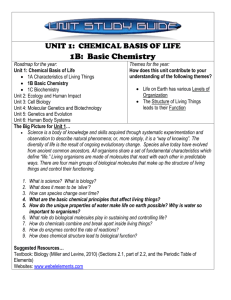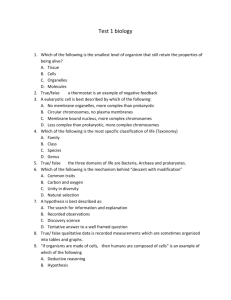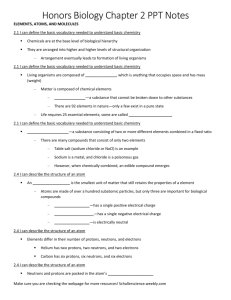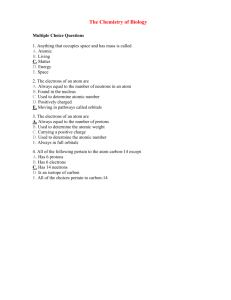Chemistry Highlights
advertisement
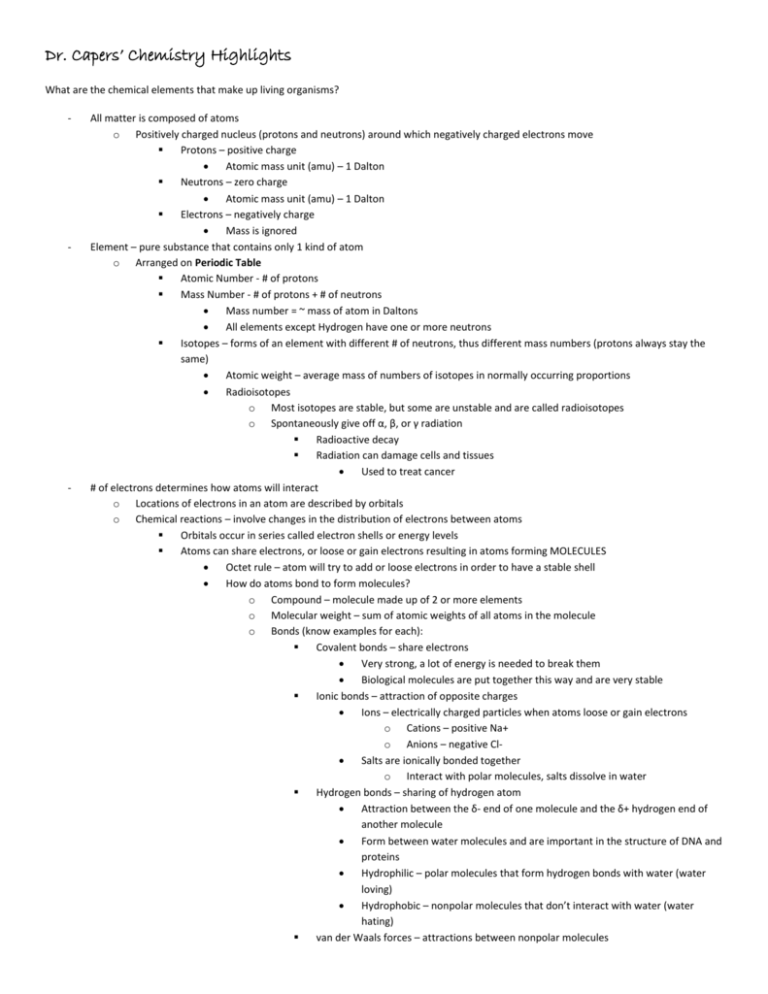
Dr. Capers’ Chemistry Highlights What are the chemical elements that make up living organisms? - - - All matter is composed of atoms o Positively charged nucleus (protons and neutrons) around which negatively charged electrons move Protons – positive charge Atomic mass unit (amu) – 1 Dalton Neutrons – zero charge Atomic mass unit (amu) – 1 Dalton Electrons – negatively charge Mass is ignored Element – pure substance that contains only 1 kind of atom o Arranged on Periodic Table Atomic Number - # of protons Mass Number - # of protons + # of neutrons Mass number = ~ mass of atom in Daltons All elements except Hydrogen have one or more neutrons Isotopes – forms of an element with different # of neutrons, thus different mass numbers (protons always stay the same) Atomic weight – average mass of numbers of isotopes in normally occurring proportions Radioisotopes o Most isotopes are stable, but some are unstable and are called radioisotopes o Spontaneously give off α, β, or γ radiation Radioactive decay Radiation can damage cells and tissues Used to treat cancer # of electrons determines how atoms will interact o Locations of electrons in an atom are described by orbitals o Chemical reactions – involve changes in the distribution of electrons between atoms Orbitals occur in series called electron shells or energy levels Atoms can share electrons, or loose or gain electrons resulting in atoms forming MOLECULES Octet rule – atom will try to add or loose electrons in order to have a stable shell How do atoms bond to form molecules? o Compound – molecule made up of 2 or more elements o Molecular weight – sum of atomic weights of all atoms in the molecule o Bonds (know examples for each): Covalent bonds – share electrons Very strong, a lot of energy is needed to break them Biological molecules are put together this way and are very stable Ionic bonds – attraction of opposite charges Ions – electrically charged particles when atoms loose or gain electrons o Cations – positive Na+ o Anions – negative Cl Salts are ionically bonded together o Interact with polar molecules, salts dissolve in water Hydrogen bonds – sharing of hydrogen atom Attraction between the δ- end of one molecule and the δ+ hydrogen end of another molecule Form between water molecules and are important in the structure of DNA and proteins Hydrophilic – polar molecules that form hydrogen bonds with water (water loving) Hydrophobic – nonpolar molecules that don’t interact with water (water hating) van der Waals forces – attractions between nonpolar molecules result from random variation in electron distribution interactions are brief and weak How do atoms change partners in chemical reactions? Chemical reactions – atoms bond or change bonding partners o Matter and energy are neither created or destroyed!! o Energy – capacity to do work or capacity for change, can change form during reactions What properties of water make it so important in biology? - Water – unique in structure and special properties o Polar molecule – forms hydrogen bonds Ice floats – molecules are not densely packed and leaves spaces, making ice less dense than water Why is this important? Unique melting, freezing, and heat capacity Required great amount of energy to melt ice, to break those hydrogen bonds High specific heat – amount of energy required to raise temp 1°C High heat of vaporization – amount of energy required to change from liquid to gas o Because of all of this, water helps to moderate the climate of the Earth Cohesion – water molecules resist coming apart from one another Helps water move through plants Results in surface tension – important for plankton Water is solvent of life A solution is a substance (solute) dissolved in a liquid (solvent) Many important biochemical reactions occur in aqueous solutions o Human body is over 70% water o Biologists study what happens in these reactions Qualitative analysis – deals with substances dissolved in water and the chemical reactions that occur there In other words – what substances are present for the reaction Quantitative analysis – deals with concentrations of products and reactants Mole – amount of substance (in grams) which is numerically equal to its molecular weight 1 mole of Na+ = 23g 1 mole of H2 = 2 g 1 mole contains 6.02 x 1023 molecules – Avogadro’s Number Think of buying a dozen o When you buy a dozen of eggs or a dozen of donuts, you know you will get 12 but they won’t weigh the same or take up the same amount of space o Aqueous solution may be acidic or basic Acids – the release hydrogen ions H+ Bases – accept H+ Living organisms must maintain internal conditions, including pH Buffering capacity






